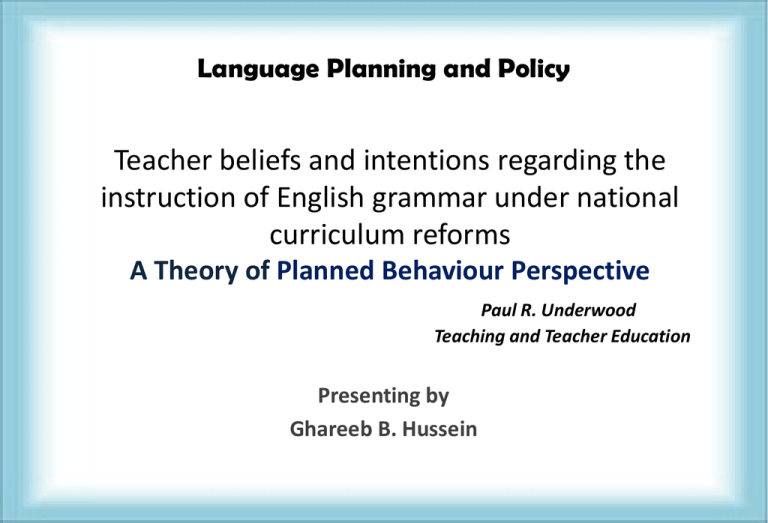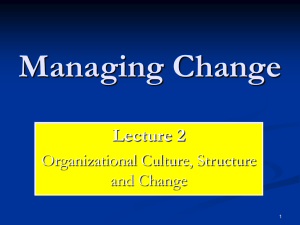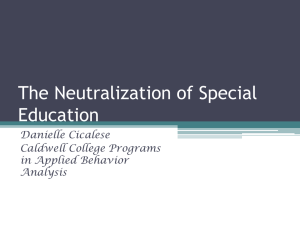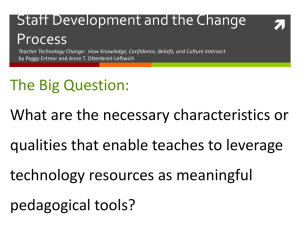Teacher Beliefs and Intentions Regarding the Instruction of English
advertisement

Language Planning and Policy Teacher beliefs and intentions regarding the instruction of English grammar under national curriculum reforms A Theory of Planned Behaviour Perspective Paul R. Underwood Teaching and Teacher Education Presenting by Ghareeb B. Hussein Introduction • In the face of the latest reforms to Japan’s national curriculum for English, this paper explored the personal, social, and context-related factors that Japanese teachers believe could influence their teaching of grammar in the context of meaning-oriented instruction. • Given that reforms to the English language component of national curricular are occurring throughout Asia, the Middle East, and other parts of the world, the findings may offer researchers and educators in similar situations further insight into the factors influencing national curricular reform in their country. The subjective reality of curriculum implementation • Successful implementation would appear to depend less on policy directives and more on the re-culturing of teachers and schools and establishing the necessary workplace conditions to support reform. (Fullan, 2007 ) • Fullan (2007) has clearly illustrated the tension between policy rhetoric and the “subjective reality” teachers face in their day-to-day work, as they deal with numerous factors which can impede their implementation of national curriculum mandates Research questions (1) What factors do Japanese teachers believe could influence their teaching of English grammar under new national curriculum reforms? (2) Which of these beliefs might be influential in determining implementation of these reforms? Factors inhibit curricular reform at the classroom level 1. Classroom conditions • Studies from a number of international settings suggest that student expectations and participation, difficulty in managing large class sizes, and issues with control can inhibit teachers’ implementation. 2. Effective teacher training: • The absence of this is often reported in Japan, and in other educational settings. • Teachers found themselves unable to apply their new skills due to adverse contextual conditions, namely, large class sizes, limited resources, and resistance from students and administration. 3. The school’s social environment • This is highlighted in Cook’s (2005) study, which found that a major barrier to applying reform-oriented training in Japanese EFL classes was the pressure to conform to “standard” teaching practices, namely, grammartranslation methodology. 4. Insufficient resources • Featuring specifically in studies are a heavy workload, insufficient curriculum time, expenses for training, and a lack of appropriate teaching materials. • Concerning materials, a number of international studies also stress the difficulties encountered using statemandated textbooks 5. Influence of high-stakes assessment on teaching and learning • In Libya, for example, Orafi and Borg (2009) discovered considerable differences between the mandates of the national curriculum and actual teaching practice, one cause being the influence of mismatched, high-stakes examinations. • In Japan also, the notion of washback is particularly relevant. One reason Japanese teachers frequently cite in justification of the predominance of grammar-translation methodology. The Theoretical background 1. Investigating teacher beliefs and motivations • Over the last decade and a half, the study of language teacher beliefs has evolved into a major area of enquiry with several influential frameworks emerging, for example, Woods’ (1996) Beliefs, Assumptions, and Knowledge (BAK) model and Pratt & Associates’ (1998) Teacher Perspectives Inventory (TPI). • They deal only with beliefs at the individual level of cognition, the social and context-related dimensions are not accounted for. 2. The Theory of Planned Behavior Theory of Planned Behavior was designed to explain and predict human behavior and to provide a framework for devising behavioral change interventions. • According to the TPB, a person’s intention, or motivation, to adopt a behavior (and the behavior itself) is influenced by three main determinants and their respective attributes: (1) behavioral beliefs and attitudes towards the behavior; (2) normative beliefs and subjective norms; (3) control beliefs and perceptions of control 3. Rationale for adopting the Theory of Planned Behavior in this study The TPB is applicable to this current study for three reasons: First, the model’s behavioral, normative, and control beliefs correspond with the various personal, social, and contextrelated factors that have emerged in the review of the literature and appear to be influential in the Japanese context • Second, in accounting for the influence of social and context-related factors in shaping teacher beliefs and intentions regarding curriculum innovation. • Third, the TPB accounts for many aspects of Borg’s (2006) LTC framework and has also been shown through several meta-analyses to be a robust model for explaining and predicting human behavior through psychological constructs such as, beliefs, attitudes, and intentions; thereby, adding to the confidence. Methodology • Overview: For the data triangulation the author used three resources: two focus groups and a semi-structured interview in one school location, and surveys administered in three other school locations. • All participants in the study received a research information sheet that explained the purpose and scope of the study, its procedures, participant roles, confidentiality, the handling and storage of data, and contact information. • Sampling and participants: 1. The focus group and interview participants: The first set of data was gathered from two focus groups and one semi-structured interview of Japanese teachers of English 2. The survey participants: The second set of data was collected from Japanese teachers working in two private schools in an urban location and one public school in a rural location Data collection • In both stages of the research, questions were open-ended in order to avoid imposing any beliefs upon the participants and influencing their responses. • The survey instrument was written in both Japanese and English. • the Japanese version of the survey was then backtranslated into English to establish equivalence with the original questionnaire • While the format and presentation of questions differed slightly between the focus groups, interview, and survey, in essence they covered three main areas of enquiry: 1. What do you think are the advantages and disadvantages of teaching according to MEXT’s proposals from 2013? 2. Can you think of anyone who might support or not support your decision to teach according to MEXT’s proposals from 2013? 3. What skills and resources do you think you will need to teach according to MEXT’s proposals from 2013? The Findings - Behavioral Beliefs • As data was triangulated through multiple sources, the findings are presented together. • Firstly, it is clear from the data that teachers generally regard the approach favorably. The department head was positive towards the new COS 2009’s approach • The survey data (Table 5.1) also reflects teachers’ positive evaluation of integrating grammar teaching with communication • In summary then, the tensions described here seem to suggest that teachers are finding difficulty in conceiving how the integration of grammar with meaning-oriented activities could be realized in their classes. The Findings- Normative Beliefs • The findings here confirm what research in other Southeast Asian countries has suggested about the centrality of student expectations. • The survey shows that many senior and novice teachers from all school types identified students as among those who would oppose a reform-oriented approach to teaching. Findings - Control Beliefs • The first theme concerns the difficulties arising from a lack of time. • A second theme concerning the teaching skills reflects the belief that having more teaching skills would better facilitate implementation of the reform • A third theme referred to the requirement of teachers to use more English in the classroom as they showed difficulty to speak grammar in English. • A fourth theme referred to teachers’ knowledge of the COS 2009. • In the survey, six of the ten teachers reported that they were only somewhat familiar with the COS and one reported that she was not familiar with it at all • Final theme was the need for more appropriate materials. • Senior teachers suggested the need for more textbooks which integrate grammar into contexts • They also showed that they were apprehensive about the amount of time that would be necessary to prepare materials to teach English communicatively Discussion • The findings presented in this current study suggest that for these teachers, the intention to adopt a reformoriented approach to the teaching of grammar is determined by the interaction of all three TPB belief areas. • The findings indicate that most teachers believe the new COS 2009 approach to integrating grammar with communication would have both instrumental advantages experiential advantages. Conclusion • Though changing teachers’ beliefs is not a straightforward process, and establishing the necessary conditions equally so, the findings of this exploratory research are the first step towards understanding teacher beliefs regarding the instruction of grammar under the new national curriculum reforms in Japan • From a theoretical perspective, the findings further illustrate how a qualitative enquiry of teacher beliefs can bring to light tensions between the ideals of national curriculum and the subjective reality facing teachers Underwood, P. (2012). Teacher beliefs regarding the integration of English grammar under new national curriculum reforms: a Theory of Planned Behaviour perspective. teaching and teacher education, 1-38.











